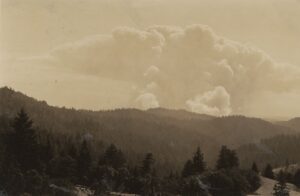For any readers unclear about the concept of defensible space please read about the massive 1931 Comptche Fire and how people survived in the middle of a firestorm. It’s a good lesson on what saves lives.

On September 22, 1931, the easterly and southeasterly portions of the Comptche settlement were swept by the worst fires in the history of the coast, the Mendocino Beacon newspaper reported. It was a quick and dirty fire that burned more than 33,000 acres 79 years ago, but a story that can help homeowners prepare for today.
Homeowner Charlotte Layton had a lovely home at Hayslett Hill on a ridge northeast of Comptche Corners. She was milking six cows to sell milk and cream, her barn was full of hay and feed for the winter, and her hog was getting fat. She had a ton of potatoes dug up and sacked and stored and 3009 quarts of canned fruit, vegetable, jellies, and meat in her pantry. Life was good.
Driving to town and the post office at Comptche Corners at noon people noticed smoke in the air. (Sound familiar?) It seemed to be coming from the direction of Big River and Nathaniel Smith Opening to the northeast. Driving to where they could see down into the drainage, locals said it sounded like a steam locomotive engine roaring uphill traveling towards Comptche. Everyone headed home to get ready.
Layton had a ranch hand drive her around to warn neighbors and turn out stock. She found her three children returning from school but discovered access back to the county road was cut off by flames. In her account of the event, Layton stated, “The wind was blowing an 80-mile gale.”
With flames moving in on her home 14 neighbors gathered at the Victor Del Grosso home to make a stand. Why? It was in the middle on a wide grassy meadow with no timber nearby. It had defensible space around it. That term hadn’t been invented yet but that’s what they had.
They parked a REO Touring Car, a Chevy, and a Whippet Sedan nearby and started wetting everything down as best they could. Men on the roof used wet cloth, curtains, and soaked quilts, slapping them up and down to extinguish embers. All interior curtains were wet down, and the children hidden in an inside room. They fought on, exhausted, while their world burned down around them.
Neighbors in town were frantic to know if the folks on the ridge survived. Men finally walked up through the fire-swept countryside in the dark of night, certain no human beings could have lived through such fire, smoke, and heat. They were overjoyed to find 14 survivors, and while the Del Grosso family stayed, the rest of the folks hiked under fallen trees, over burnt culverts and along blackened ridges to reach the valley floor where they were sheltered by neighbors at intact houses.
It was a capricious fire jumping all over the place. It burned as far west as Melbourne (the current Tunzi Ranch), round the ridges on north of the Comptche Valley, and up the hills to the east. It sent fingers of flame down on to the valley floor, one coming within a half mile of our Tahja family ranch a mile east of Comptche Corners. It spread south, endangered the Keene Summit area, spread through the Flynn Hills, and darn near made it to the Navarro River. All this, from Big River to the Navarro River, in little over a day.
Charlotte Layton lost everything. She found some livestock and her dog and cat survived in the orchard, but she had to start over. The Red Cross actually came in, built her a simple home, and even gave her cows and feed for them. They also built cabins for other burned-out settlers. It was an organization trained to help, even during the Great Depression.
Lumber companies hired crews to fight the fire. Backfires were set to create barriers. No one wanted to see the fire jump Flynn Creek and get into timberlands then owned by Southern Pacific Railroad. Two million young trees, about four years old planted for reforestation, went up in flames. The fire didn’t spread further but flames remained in stumps and roots until the winter rains came.
How did that fire start? Mendocino Lumber Company was offering a $250 reward in 1932 for any information leading to the arrest and conviction of the fire starter. No luck. But rumors went on for years. It did not start from logging, as there was none in operation within five miles of the origin of the fire. The best guess was deer hunters. Trying to make better hunting grounds along Big River, they wanted the brush out of the way and started a brush fire. No one was ever blamed.
So, think about that Del Grosso home sitting in its wide-open meadow and think about defensible space around where you live. Keep it open around your home. Be fire safe. (And don’t stack your dry winter firewood on your front porch).